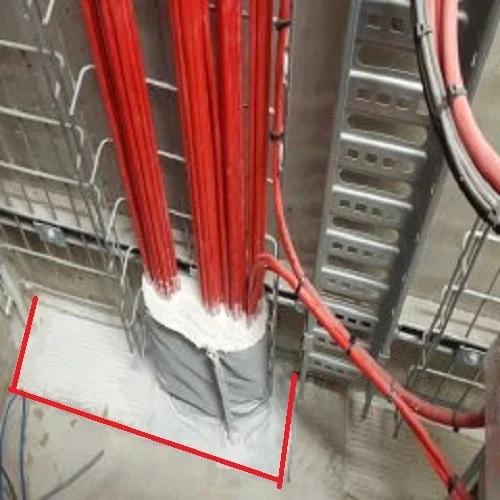Fire Protection Electrical Shaft Sealing

Electrical Shaft Sealing
The Importance of Fire Protection Electrical Shaft Sealing for Firefighting
Fire safety is paramount in safeguarding lives, property, and the environment, especially in industrial, commercial, and residential spaces. Among the critical elements of a comprehensive fire protection system is fire protection electrical shaft sealing. This system plays a vital role in preventing the spread of fire, smoke, and toxic gases through electrical shafts, which are common conduits for these hazards during an emergency. In this article, we will delve into the importance of fire protection electrical shaft sealing for firefighting, explore its components and benefits, and explain why Angel Safety Consultants is the right partner for ensuring optimal fire safety solutions.
What is Fire Protection Electrical Shaft Sealing?
Electrical shafts are often used in buildings to house cables, wires, and electrical conduits that run through multiple floors or walls. While essential for the functionality of modern buildings, these shafts can also become pathways for fire, smoke, and gases to travel from one area to another, especially in high-rise buildings or complex facilities.
Fire protection electrical shaft sealing refers to the use of specialized materials and systems designed to seal electrical shafts and prevent the passage of fire, smoke, and gases during an emergency. These sealing solutions are applied at the openings where electrical cables or conduits pass through floors, walls, and ceilings. The primary objective is to contain the spread of fire and smoke, protect critical electrical infrastructure, and enhance the overall fire safety of the building.
How Does Fire Protection Electrical Shaft Sealing Work?
Fire protection electrical shaft sealing works by creating a barrier that prevents fire, smoke, and other hazardous materials from traveling through electrical shafts. The sealing material used is typically a fire-resistant compound that expands when exposed to heat, effectively blocking the shaft and preventing the passage of flames and gases.
The sealing system is strategically installed around electrical cables and conduits where they penetrate floors, walls, and ceilings. These seals are designed to remain intact and functional for a certain period during a fire, allowing enough time for building occupants to evacuate and for fire suppression systems to control the blaze.
Importance of Fire Protection Electrical Shaft Sealing for Firefighting
1. Containment of Fire and Smoke :
The primary function of fire protection electrical shaft sealing is to prevent the spread of fire and smoke from one floor to another or between different parts of the building. Electrical shafts, being vertical conduits, can act as chimneys, allowing fire and smoke to travel quickly through the building. Effective sealing ensures that fire and smoke do not reach unintended areas, limiting the damage caused by the fire.
2. Protection of Critical Infrastructure :
Electrical systems are often crucial for the operation of fire alarms, emergency lighting, and other safety equipment. If fire or smoke reaches the electrical shafts, it can damage these systems, leading to power failure and compromised fire safety. By sealing electrical shafts, the integrity of these systems is maintained, ensuring that they remain operational during a fire emergency.
3. Improved Fire Resistance :
Fire protection electrical shaft sealing provides an additional layer of fire resistance to the building’s structure. It enhances the overall fire-resistance rating of walls, floors, and ceilings, allowing them to withstand higher temperatures for longer periods. This helps in protecting the building’s structural integrity, preventing collapse, and buying valuable time for fire evacuation and suppression.
4. Compliance with Fire Safety Regulations :
Fire safety regulations and building codes often require the installation of fire protection measures in electrical shafts, particularly in high-rise buildings, industrial facilities, and commercial properties. Fire protection electrical shaft sealing ensures compliance with these regulations, reducing the risk of penalties, legal liabilities, and insurance complications. It also helps building owners and managers meet local and international fire safety standards.
5. Prevention of Toxic Gas Spread :
Fires often produce toxic gases and smoke that can be harmful or even fatal to individuals. Electrical shafts can allow these dangerous substances to spread rapidly through a building, putting occupants at risk. Fire protection seals prevent the movement of these toxic gases, improving the safety and health of building occupants during a fire emergency.
6. Enhanced Occupant Safety :
The safety of building occupants is always the top priority during a fire. Effective fire protection electrical shaft sealing ensures that people can evacuate safely without encountering dangerous smoke or fire conditions. The barrier created by the seals slows down the spread of fire and smoke, allowing more time for evacuation and reducing the potential for injury or death.
7. Cost Savings :
Although the installation of fire protection electrical shaft sealing may seem like an additional expense, it is a wise investment in the long run. By preventing the spread of fire and smoke, these seals can reduce the extent of fire damage and the costs associated with repairs, replacements, and business downtime. Moreover, by protecting critical fire safety infrastructure, fire protection electrical shaft sealing helps ensure that fire alarms and emergency systems continue to function, thus minimizing damage to the building and its contents.
8. Minimizing Fire Spread to Other Floors :
High-rise buildings are especially vulnerable to fire spread through electrical shafts. A fire on one floor can quickly travel up or down through the electrical shafts, affecting multiple floors. Fire protection electrical shaft sealing is particularly important in such buildings, as it creates a barrier that prevents fire from moving between floors and reduces the overall impact of the fire.
9. Protection During Firefighting Operations :
During firefighting operations, it is essential to contain the fire and prevent it from spreading to other parts of the building. Fire protection electrical shaft sealing helps firefighters by limiting the movement of smoke, heat, and fire. This makes it easier to contain the fire and focus efforts on extinguishing it without worrying about the spread through electrical shafts.
10. Durability and Long-Lasting Protection :
Fire protection electrical shaft sealing materials are designed to withstand extreme temperatures and environmental conditions. They are durable and provide long-lasting protection, ensuring that the system remains effective for many years. Regular inspections and maintenance help ensure that the seals continue to perform as expected over time.
Types of Fire Protection Electrical Shaft Sealing Systems
Several different types of fire protection electrical shaft sealing systems are available, depending on the specific needs and requirements of the building:
1. Firestop Collars :
Firestop collars are devices that encircle electrical cables where they pass through floors or walls. These collars expand when exposed to heat, sealing the shaft and preventing the spread of fire.
2. Fire Protection Sealant :
Fire protection sealants are applied directly to the gaps and joints around electrical cables and conduits. These sealants are fire-resistant and can expand to fill the gap when exposed to heat, providing a robust barrier against fire and smoke.
3. Fire-Rated Cable Trays :
Cable trays used to house electrical cables can be fire-rated to provide additional protection. Fire-rated trays are designed to prevent the spread of fire and smoke through the electrical shaft.
4. Fire-Rated Plugs and Caps :
In some cases, fire-rated plugs and caps are used to seal off unused openings in electrical shafts. These plugs prevent the passage of fire, smoke, and gases through the unused portions of the shaft.
5. Intumescent Materials :
Intumescent materials are often used in fire protection electrical shaft sealing. These materials expand when exposed to heat, effectively sealing the shaft and preventing the passage of fire and smoke.
Why Choose Angel Safety Consultants for Fire Protection Electrical Shaft Sealing?
At Angel Safety Consultants, we specialize in providing customized fire safety solutions that are designed to meet the unique needs of your building. Our team of experts can help you select and install the best fire protection electrical shaft sealing system for your property, ensuring maximum protection against fire and smoke.
We offer:
• Comprehensive assessment and planning for fire protection electrical shaft sealing.
• High-quality, fire-resistant sealing materials that meet industry standards.
• Professional installation and integration with your building’s fire safety systems.
• Ongoing maintenance and support to ensure optimal performance of your fire protection seals.
• Compliance with local and international fire safety regulations.
In conclusion, fire protection electrical shaft sealing is a vital component of any fire safety strategy, offering essential protection against the spread of fire and smoke. By choosing Angel Safety Consultants, you can ensure that your building is equipped with the most effective sealing solutions available, protecting both your infrastructure and the safety of your occupants.
